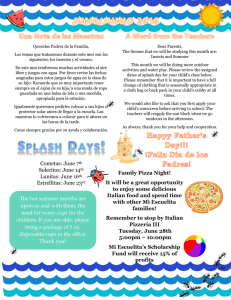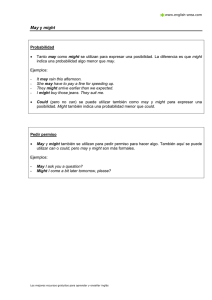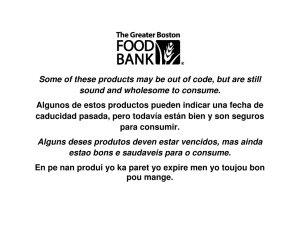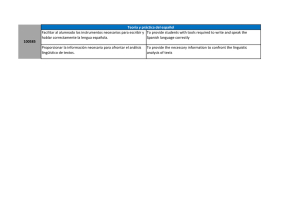Lesson 15 Notes
Anuncio
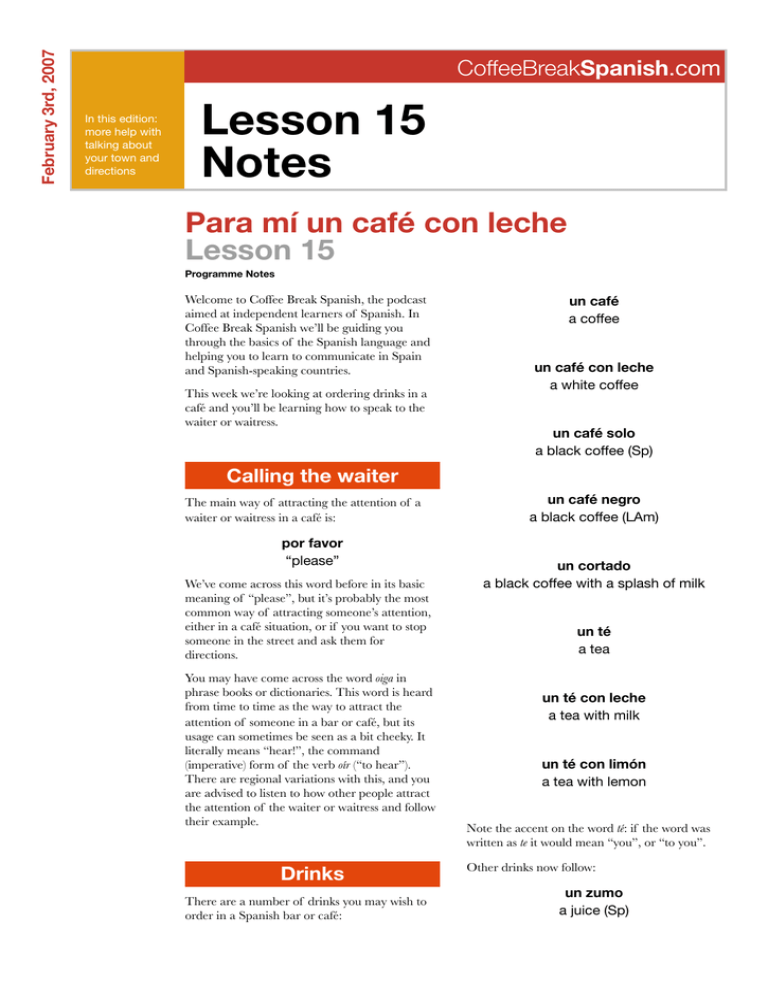
February 3rd, 2007 CoffeeBreakSpanish.com In this edition: more help with talking about your town and directions Lesson 15 Notes Para mí un café con leche Lesson 15 Programme Notes Welcome to Coffee Break Spanish, the podcast aimed at independent learners of Spanish. In Coffee Break Spanish we’ll be guiding you through the basics of the Spanish language and helping you to learn to communicate in Spain and Spanish-speaking countries. This week we’re looking at ordering drinks in a café and you’ll be learning how to speak to the waiter or waitress. un café a coffee un café con leche a white coffee un café solo a black coffee (Sp) Calling the waiter The main way of attracting the attention of a waiter or waitress in a café is: por favor “please” We’ve come across this word before in its basic meaning of “please”, but it’s probably the most common way of attracting someone’s attention, either in a café situation, or if you want to stop someone in the street and ask them for directions. You may have come across the word oiga in phrase books or dictionaries. This word is heard from time to time as the way to attract the attention of someone in a bar or café, but its usage can sometimes be seen as a bit cheeky. It literally means “hear!”, the command (imperative) form of the verb oír (“to hear”). There are regional variations with this, and you are advised to listen to how other people attract the attention of the waiter or waitress and follow their example. un café negro a black coffee (LAm) un cortado a black coffee with a splash of milk un té a tea un té con leche a tea with milk un té con limón a tea with lemon Note the accent on the word té: if the word was written as te it would mean “you”, or “to you”. Other drinks now follow: Drinks There are a number of drinks you may wish to order in a Spanish bar or café: 1 un zumo a juice (Sp) un zumo de naranja an orange juice una cerveza a beer un jugo a juice (LAm) una caña small beer (approx. half pint) un jugo de naranja an orange juice (LAm) un vino a wine un zumo/jugo de manzana an apple juice un vino tinto a red wine un zumo/jugo de piña a pineapple juice un vino blanco a white wine una limonada a lemonade Asking for drinks Note that limonada is feminine, in comparison with all other drinks we’ve learned so far. See the bonus vocabulary for more examples. The most basic way of requesting a drink is by saying, “I want...”: The word for “water” in Spanish is: quiero... I want... el agua water You may immediately think this is a bit strange: agua seems to be feminine and ends in -a, but uses the word “el” for “the”. Also, when you ask for “a mineral water”, you say: un agua mineral a mineral water Perhaps a less direct way of asking for a drink is: para mí for me Equally you can ask for things for other people: para mi amigo for my friend However, agua is indeed feminine, but uses el and un because una agua and la agua would sound strange to a Spanish speaker. The same happens with other words, eg. el ama de casa (the housewife), el arca (the ark), el arpa (the harp). para mi mujer/esposa for my wife To specify if you want a still or sparkling mineral water, you use the following words: un agua mineral sin gas still mineral water un agua mineral con gas sparkling mineral water Let’s move on now to some alcoholic drinks. 2 Note the difference between the words mí and mi (ie. with and without accent): mi my mí me (as in “for me”) When the word carries an accent – mí – it means “me”, as in para mí, “for me”. When it has no accent – mi – it means “my”, as in mi amigo. What they’ll say... The most likely question the waiter or waitress will ask you is: Conversación 2 In this conversation, note how the waitress addresses “Mark” formally, using para usted and she uses the informal form with Matthew: para ti. Mark: ¿qué van a tomar? what would you like? Por favor... Camarera: Buenas tardes. ¿Qué van a tomar? Literally ¿qué van a tomar? means “what are you going to have” in the formal version. You may also hear: ¿qué quiere tomar? what would you like? (singular) Mark: Bueno, para mí un café con leche. Matthew: Y para mí un zumo de piña. Camarera: Muy bien. Pues, para usted un café con leche y para ti un zumo de piña. Mark: Es así. Muchas gracias. Camarera: En seguida. ¿qué quieren tomar? what would you like? (plural) Camarera: ¿El zumo de piña? Matthew: Conversación 1 The first conversation included in lesson 15 was included as an example of how you use the phrases we’ve learned in context. Kara: Para mí un café con leche y para mi amigo una limonada. Camarero: Muy bien. Pues, un café con leche para usted y para su amigo una limonada. Kara: Camarera: ¿Y el café con leche es para usted, señor? Mark: Sí. Muchas gracias. Camarera: De nada. Por favor... Camarero: ¿Sí? ¿Qué van a tomar? Kara: Sí. Para mí, gracias. Sí. A translation of the above conversation should help you get to grips with all aspects of the language covered in today’s lesson: Mark: Excuse me.. Camarero: Muy bien. En seguida. Camarera: Good afternoon. What would you like? Kara: Mark: Well, for me a white coffee. Matthew: And for me a pineapple juice. Gracias. The waiter finishes with the phrase en seguida, meaning “straight away”, as in “I’ll bring your drinks as soon as possible”. Cheers! Camarera: OK, so for you a white coffee and for you a pineapple juice? Mark: That’s right. Thank you very much. Camarera: I’ll get these for you right away. Finally, you need to know the word for “Cheers!”: ¡salud! Cheers! Camarera: The pineapple juice? Matthew: The word salud literally means “health”. Yes, that’s for me. Thank you. Camarera: And the white coffee is for you, sir? Mark: Yes, thank you. Camarera: No problem. 3 CoffeeBreakSpanish: Lesson 15 - Basic Vocabulary el café coffee el café con leche white coffee la leche milk el café solo black coffee (Sp) el café negro black coffee (LAm) el cortado black coffee with a little milk el té tea el té con limón tea with lemon el zumo / el jugo juice el zumo / jugo de naranja orange juice el zumo / jugo de manzana apple juice el zumo / jugo de piña pineapple juice la limonada lemonade el agua (f) water el agua mineral mineral water ...con gas sparkling ...sin gas still la cerveza beer la caña “half pint of beer” el vino wine el vino tinto red wine el vino blanco white wine quiero... I want para mí for me para mi amigo for my friend salud cheers (lit. “health”) CoffeeBreakSpanish: Lesson 15 - Bonus Vocabulary un vaso de ... a glass of ... una copa de ... a glass of ... (normally used for wine) una botella de ... a bottle of ... una taza de ... a cup of ... un café descafeinado decaffeinated coffee un café carajillo liqueur coffee 4 una coca cola coke una fanta (de naranja) fizzy (orange) un anís anise (aniseed schnapps) una sidra cider un coñac brandy un ron rum una sangría sangria (punch based on red wine) un jerez sherry un güisqui whisky un trago de... a shot of... pisco pisco - South American grape brandy ginebra gin tequila tequila vodka vodka Be aware that some of the drinks listed above are regional, eg. you’re much more likely to find pisco in South America than in Spain. Equally, anís is more common in Spain than in most parts of Latin America. CoffeeBreakSpanish.com All materials ©Copyright Radio Lingua International 2007 5
